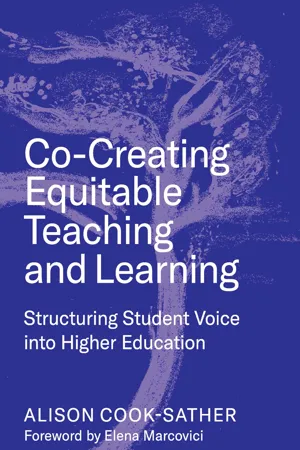
Co-Creating Equitable Teaching and Learning
Structuring Student Voice into Higher Education
- 240 pages
- English
- ePUB (mobile friendly)
- Available on iOS & Android
Co-Creating Equitable Teaching and Learning
Structuring Student Voice into Higher Education
About This Book
Co-Creating Equitable Teaching and Learning invites readers to help forge a more inclusive and accessible college education by incorporating student voices via pedagogical partnerships.
Alison Cook-Sather, a pioneer of this co-creative approach, draws on more than twenty years of experience developing student–teacher partnerships in higher education to offer a wise and generous work that speaks to both students and educators. As her research underscores, a co-creative learning environment, in which relationships and communication between students and teachers are prioritized, benefits the educational experience on many levels.
Cook-Sather demonstrates how pedagogical partnerships give students the tools to advocate for their own learning while giving educators the feedback they need to improve classroom experiences. She shows how the co-creative model helps to bring about inclusive spaces and equitable teaching practices that better foster student success, especially among underrepresented and minority student populations.
Offering actionable guidance, Cook-Sather advocates enacting the following four principles to structure student voice into higher education: embracing a commitment to equity and justice; providing structure rather than prescriptions for engagement; making rather than taking up space; and developing a partnership mindset. She grounds these principles in examples of practices drawn from an undergraduate education course; a faculty development program; and cross-disciplinary, cross-constituency institutional dialogues.
This work calls for readers to reimagine the higher education structure and to cultivate an environment in which all stakeholders can work together to advance inclusivity, accessibility, and equity. As the author argues, co-creation can be a catalyst for change throughout the system.
Frequently asked questions
Information
Table of contents
- Cover
- Frontispiece
- Title Page
- Copyright
- Dedication
- Contents
- Foreword
- Preface
- Chapter One: What Does It Mean to Co-create Equity in Higher Education?
- Chapter Two: Be Guided by a Commitment to Equity and Justice
- Chapter Three: Provide Structures, Not Prescriptions, for Engagement
- Chapter Four: Make Rather Than Take Up Space
- Chapter Five: Strive Toward Partnership
- Afterword
- Notes
- Bibliography
- Acknowledgments
- About the Author
- Index